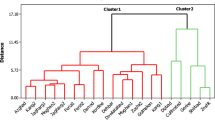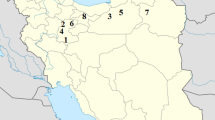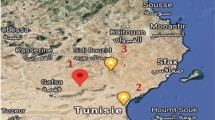Abstract
In the present work, natural populations of Sideritis pisidica Boiss. & Heldr. from 19 different localities in Turkey have been comprehensively investigated with taking into consideration the environmental factors and phytochemical composition and yield of the essential oils. The essential oils were obtained by the hydrodistillation of the aerial parts of plant samples. The chemical compositions of the essential oils were analyzed with GC-FID and GC/MS techniques. The main chemical compositions were evaluated with the Principal Component Analysis. The relationship between the oil yields, main chemical constituents, and site factors were determined by correlation analysis. A total of 188 compounds and 6 main constituents were detected in the essential oils of S. pisidica. In general, the oils were mostly constituted by monoterpene hydrocarbons, oxygenated sesquiterpene, sesquiterpene hydrocarbons and diterpenes. β-Caryophyllene (0–40.3%), α-pinene (0–27.8%), sabinene (0–17.6%), α-bisabolol (0–20.9%), myrcene (0–13.8%), β-pinene (0–14.1%), caryophyllene oxide (0.2–13.3%) and 2-keto-manoyloxide (0–25.8%) were found in high amounts. There was a positive relationship between the amount of Mn in the soil and sabinene, β-pinene and linalool and caryophyllene II, but there was a negative relationship with caryophyllene oxide. As the elevation and Ca amount increased, the ratio of 2-keto-manoyloxide and diterpene-IV from the diterpenes increased, too, but the myrcene decreases. In conclusion, data about essential oil compositions and site factors in studied S. pisidica samples could provide useful informations for conservation, cultivation and for clone selection in breeding studies. In addition, the chemical distribution of the essential oil compounds could be useful in means of chemotaxonomy.



Similar content being viewed by others
REFERENCES
Adams, R.P., Identification of Essential Oil Components by Gas Chromatography/Mass Spectrometry, Carol Stream, IL: Allured, 2007, 4th ed.
Aertsen, W., Kint, V., van Orshoven, J., Özkan, K., and Muys, B., Comparison and ranking of different modeling techniques for prediction of site index in Mediterranean mountain forests, Ecol. Model., 2010, vol. 221, no. 8, pp. 1119–1130.
Akman, Y., İklim ve Biyoiklim (Biyoiklim Metodları ve Türkiye İklimleri), Ankara: Kariyer Matbaacılık, 1999.
Allison, L.E. and Moodie, C.D., Carbonate, in Methods of Soil Analysis, Part 2: Chemical and Microbiological Properties, Norman, A.G., Ed., Madison, WI: Am. Soc. Agron., 1965, pp. 1379–1396.
Apostolos, G., Genetic studies on Greek mountain tea (Sideritis L.), Lamiales Newsl., 1997, vol. 5, pp. 8–9.
Başer, K.C.H. Aromatic biodiversity among the flowering plant taxa of Turkey, Pure Appl. Chem., 2002, vol. 74, no. 4, pp. 527–545.
Baytop, T., Türkiye`de Bitkilerle Tedavi, İstanbul: İstanbul Üniv. Yayınları, 1984.
Bergman, W., Nutritional Disorders of Plants, Development, Visual and Analytical Diagnosis, Jena: Gustav Fischer, 1992.
Bro, R. and Smilde, A.K., Principal component analysis, Anal. Methods, 2014, vol. 6, no. 9, pp. 2812–2831.
Davis, P.H., Distribution patterns in Anatolia with particular reference to endemism, in Plant Life of South-West Asia, Davis, P.H., Harper, P.C., and Hedge, I.C., Eds., Edinburgh: Bot. Soc. Edinburgh, 1971.
Davis, P.H., Flora of Turkey and the East Aegean Islands, Edinburgh: Edinburgh Univ. Press, 1982, vol. 7.
Davis, P.H., Mill, R.R., and Tan, K., Flora of Turkey and the East Aegean Islands, Edinburgh: Edinburgh Univ. Press, 1988, suppl. 1.
Deveci, E., Tel Çayan, G., Yıldırım, H., and Duru, M.E., Chemical composition, antioxidant, anticholinesterase and anti-urease activities of Sideritis pisidica Boiss. & Heldr. endemic to Turkey, Marmara Pharm. J., 2017, vol. 21, no. 4, pp. 898–905.
Dulger, B., Gonuz, A., and Bican, T., Antimicrobial studies on three endemic species of Sideritis from Turkey, Acta Biol. Cracov., 2005, vol. 47, no. 2, pp. 153–156.
Duman, H., Sideritis, in Türkiye Bitkileri Listesi (Damarlı Bitkiler), Güner, A., Aslan, S., Ekim, T., Vural, M., Babaç, M.T., Eds., İstanbul: Nezahat Gökyiğit Botanik Bahçesi ve Flora Araştırmaları Derneği Yayını, 2012, pp. 585–588.
Ergun, M., Ergun, N., and Ozbay, N., Analysis of volatile constituents of Sideritis pisidica Boiss. & Heldr. by head space gas chromatography mass spectrometry (HS–GC/MS), Z. Arznei- Gewuerzpflanzen, 2016, vol. 21, no. 2, pp. 68–72.
Fadil, M., Farah, A., Ihssane, B., Haloui, T., Lebrazi, S., Zghari, B., and Rachiq, S., Chemometric investigation of light-shade effects on essential oil yield and morphology of Moroccan Myrtus communis L., SpringerPlus, 2016, vol. 5, no. 1, pp. 1–14.
Figueiredo, A.C., Barroso, J.G., Pedro, L.G., and Scheffer, J.J., Factors affecting secondary metabolite production in plants: Volatile components and essential oils, Flavour Fragrance J., 2008, vol. 23, no. 4, pp. 213–226.
Fraga, B.M., Phytochemistry and chemotaxonomy of Sideritis species from the Mediterranean region, Phytochemistry, 2012, vol. 76, pp. 7–24.
Gómez-Serranillos, M.P., El-Naggar, T., Villar, A.M., and Carretero, M.E., Analysis and retention behavior in high-performance liquid chromatography of terpenic plant constituents (Sideritis spp.) with pharmacological interest, J. Chromatogr., B, 2004, vol. 812, nos. 1–2, pp. 379–383.
González-Burgos, E., Carretero, M.E., and Gómez-Serranillos, M.P., Sideritis spp.: Uses, chemical composition and pharmacological activities—A review, J. Ethnopharmacol., 2011, vol. 135, no. 2, pp. 209–225.
Güvenç, A., Houghton, P.J., Duman, H., Coşkun, M., and Şahin, P., Antioxidant activity studies on selected Sideritis species native to Turkey, Pharm. Biol., 2005, vol. 43, no. 2, pp. 173–177.
Huber-Morath, A., Sideritis L., in Flora of Turkey and the East Aegean Islands, Davis, P.H., Ed., Edinburgh: Edinburgh Univ. Press, 1982, vol. 7, pp. 178–199.
Joulain, D., König, W., and Hochmuth, D., Terpenoids and related constituents of essential oils, 2001. https://massfinder.com. Cited May 16, 2019.
Kacar, B., Bitki ve Toprağın Kimyasal Analizleri: III, Toprak Analizleri, Ankara: Ankara Üniv., 1994.
Kacar, B., Toprak Analizleri, Nobel Yayın dağıtım. 2. Basım, Ankara: Nobel Yayınları, 2009.
Kılıc O., Essential oil composition of two Sideritis L. taxa from Turkey: A chemotaxonomic approach, Asian J. Chem., 2014, vol. 26, no. 8, pp. 2466–2470.
Kirimer, N., Tabanca, N., Özek, T., Tümen, G., and Baser, K.H.C., Essential oils of annual Sideritis species growing in Turkey, Pharm. Biol., 2000, vol. 38, no. 2, pp. 106–111.
Kirimer, N., Baser, K.H.C., Demirel, B., and Duman, H., Essential oil of Sideritis species of turkey belonging to the section Empedoclia, Chem. Nat. Compd., 2004, vol. 40, pp. 18–21.
Kroetsch, D. and Wang, C., Particle size distribution, in Soil Sampling and Methods of Analysis Physical Analysis, Carter, M.R. and Gregorich, E.G., Eds., Boca Raton, FL: CRC, 2008, pp. 713–725.
Li, Y.L., Craker, L.E., and Potter, T., Effect of light level on essential oil production of sage (Salvia officinalis) and thyme (Thymus vulgaris), Proc. Int. Symp. on Medicinal and Aromatic Plants, Amherst, MA, 1995, pp. 419-426.
McCune, B. and Mefford, M.J., PC-ORD. Multivariate Analysis of Ecological Data, Version 6.07, Gleneden Beach, OR: MjM Software Design, 2011.
Moisen, G.G. and Frescino, T.S., Comparing five modeling techniques for predicting forest characteristics, Ecol. Model., 2002, vol. 157, nos. 2–3, pp. 209–225.
NIST Chemistry WebBook, 2018. https://webbook.nist. 474.gov/chemistry/. Cited October 21, 2019.
Özek, G., Bedir, E., Tabanca, N., Ali, A., Khan, I., et al., Isolation of eudesmane type sesquiterpene ketone from Prangos heyniae H. Duman & M.F. Watson essential oil and mosquitocidal activity of the essential oils, Open Chem., 2018, vol. 16, no. 1, pp. 453–467.
Özel, M.Z. and Kutlular, O., Regional changes in the chemical composition of essential oils of Salvia fruticosa and Sideritis pisidica using superheated water extraction, Anal. Chem. Lett., 2011, vol. 1, no. 1, pp. 34–42.
Özkan, G., Krüger, H., Schulz, H., and Özcan, M., Essential oil composition of three Sideritis species used as herbal teas in Turkey, J. Essent. Oil Bearing Plants, 2005, vol. 8, no. 2, pp. 173–177.
Soil textural triangle, Natural Resources Conservation Service, US Department of Agriculture, 2018. https:// www.nrcs.usda.gov. Cited May 2, 2019.
Todorova, M., Trendafilova, A., Evstatieva, L., and Antonova, D., Influence of ecological factors on the essential oil composition of Sideritis scardica Griseb, in Proc. VII Conf. on Medicinal and Aromatic Plants of Southeast European Countries (CMAPSEEC), Subotica, 2012, pp. 63–67.
TS 8336: Soils-Determination of Organic Matter, Ankara: Turk. Stand. Inst. Press, 1990a.
TS 8340: Soils-Determination of Phosphorus (Olsen et al. Method), Ankara, Turkey: Turk. Stand. Inst. Press, 1990b.
TS 8338: Soils-Determination of Phosphorus (Modified Bray and Kurtz No. 1 Method), Ankara: Turk. Stand. Inst. Press, 1990c.
TS ISO 11265: Soil Quality-Determination of Electrical Conductivity, Ankara: Turk. Stand. Inst. Press, 1996.
TS ISO 10390: Soil Quality-Determination of pH, Ankara: Turk. Stand. Inst. Press, 2013.
Wiley registry: Mass spectral library, 11th ed., 2017. https:// www.wiley.com. Cited May 20, 2018.
ACKNOWLEDGMENTS
This study was supported by the research project “Relationships Between Essential Oil Content and Growth Environment Properties of Three Aromatic Plants Collected as Oregano and Mountain Tea (Sideritis condensata Boiss. & Heldr., S. pisidica Boiss. & Heldr. ve Origanum minutiflorum O. Schwarz & P.H.Davis (ESK-21(6316)” from the Research Institute for Forest Soil and Ecology (Turkey). Authors express their thanks to Prof. Dr. Hayri Duman (Gazi Üniversity, Turkey) for helping in plant botanical identification. We thanks to staff of ANK (Ankara University, Herbarium of the Department of Biology), GAZI (Gazi University Herbarium) and ISTE (Istanbul University, Herbarium of the Faculty of Pharmacy) herbaria for help with Sideritis pisidica herbaria data.
Author information
Authors and Affiliations
Corresponding authors
Ethics declarations
The authors declare that they have no conflicts of interest.
APPENDIX 1
APPENDIX 1
1.1 GC-MS
The volatiles were analyzed by GC-FID and GC-MS techniques. The GC-MS analysis was carried out with an Agilent 5975 GC-MSD system (Agilent Technologies, Santa Clara, USA). HP-Innowax FSC column (60 m × 0.25 mm, 0.25 µm film thickness, Agilent, Walt & Jennings Scientific, Wilmington, DE, USA) was used with a helium carrier gas at 0.8 mL/min. GC oven temperature was kept at 60°C for 10 min and programmed to 220°C at a rate of 4°C/min, kept constant for 10 min at 220°C, and then programmed to increase at a rate of 1°C/min to 240°C. The oil was analyzed with a split ratio of 40 : 1. The injector temperature was 250°C. Mass spectra were taken at 70 eV and the mass range was from m/z 35 to 450. Experiments were performed in triplicate.
1.1.1 GC-FID
The GC-FID analysis was carried out with capillary GC using an Agilent 6890N GC system (Agilent Technologies, Santa Clara, USA). Flame ionization detector (FID) temperature was set at 300ºC in order to obtain the same elution order with GC-MS. Simultaneous injection was performed using the same column and appropriate operational conditions. Experiments were performed in triplicate.
Rights and permissions
About this article
Cite this article
Münevver Arslan, Özek, G. & Özek, T. Essential Oil Compositions and Site Characteristics of Sideritis pisidica in Natural Habitat. Contemp. Probl. Ecol. 14, 675–689 (2021). https://doi.org/10.1134/S1995425521060020
Received:
Revised:
Accepted:
Published:
Issue Date:
DOI: https://doi.org/10.1134/S1995425521060020




